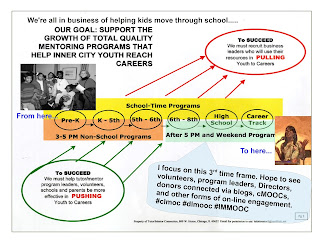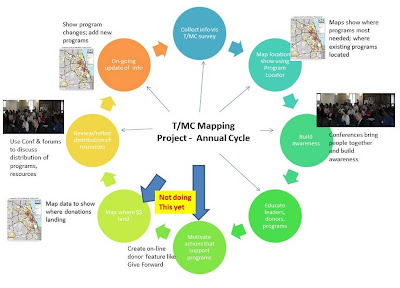Someone who is inspired by the good work being done by others, is represented by the "rabbit" who is always looking for good ideas, or better ways to operate. In this graphic, the "rabbits" are the most aggressive innovators. The dogs, chasing the rabbit, are other organizations, who are following the example provided by "rabbits", and trying to use the same good ideas to improve their own organizations.
We need a constant flow of ideas, and operating dollars, in every high poverty zip code of the country, to support what we do to help kids through school and into adult lives. Since that's not happening, we need to innovate new ways to make it happen.
Below is another article that shows the innovation process.
In this graphic I compare the innovation and constant learning needed to help schools and non-school youth serving organizations have a long-term impact on the lives of kids (and volunteers) to the thousand experiments that led Thomas Edison to invent the light bulb. In this graphic I also try to remind leaders of the resources they need to provide for many years, for light bulbs (great programs) to be available in all of the neighborhoods where they are needed, and for all the years they need to be in place.
I started building a library of research and peer tutor/mentor program information in the 1970s, to stimulate the thinking and innovation of volunteers working with me to build the tutor/mentor program I was leading at the Montgomery Ward Corporation in Chicago. As I created my library, began sharing it with peers, leading other programs. I formalized this information collection/sharing in 1993 when I created the Tutor/Mentor Connection. Now I host an extensive web library, with links to more than 2000 other web sites, that anyone in Chicago, or the world, can dig into to find "carrots" that inspire their own innovation and constant improvement.
In the Scribd.com pdf below, I show how the information in web libraries can stimulate constant innovation and improvement, if given support by others who take on intermediary roles and champion the work we do to help kids move through school and into careers.
Using Ideas to Stimulate Competition and Process Improvement - Concept Paper by Daniel F. Bassill
Between 2006 and 2015 interns working with me in Chicago have created new visualizations re-interpreting some of the ideas and graphics I've introduced in this blog. See a collection of these here.
I'd love to see others, not just interns working with me, make their own versions of the ideas I share in my blogs, focusing on their own communities and causes, not just Chicago, or volunteer-based tutor/mentor programs.
I've participated in Making Learning Connected MOOC and others like it because thousands of innovative educators are meeting and sharing ideas for inspiring students. I learn new ideas and ways of communicating from my participation in these events. That's how I've built my web library over the past 20 years.
I hope some will inspire their students to become intermediaries like myself, using the ideas I and others share, to motivate adults in their communities to do the work needed to assure an equal opportunity for the American Dream for everyone in their community, not just those lucky enough to have been born out of poverty, or to be in a classroom with a super inspired teacher.
This graphic was created by an intern about 10 years ago. It shows the role of "learning communities". They are like "Bible study" groups. Someone provides a "reading assignment" then leads a discussion of what was read.
If you do create a version of one of my ideas, just give me credit and send me the link so I can share it with others.
I'm still on Twitter (but see many leaving that platform due to recent ownership changes). I'm also on LinkedIn, Facebook and Instagram. (see links here). If you know of new spaces where I can share my library and ideas and find several thousand others to connect and learn from, let me know.






































